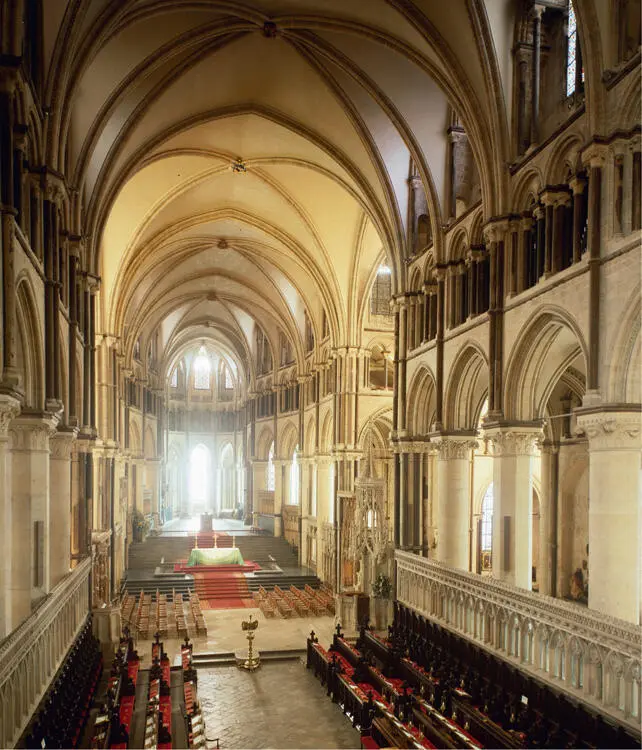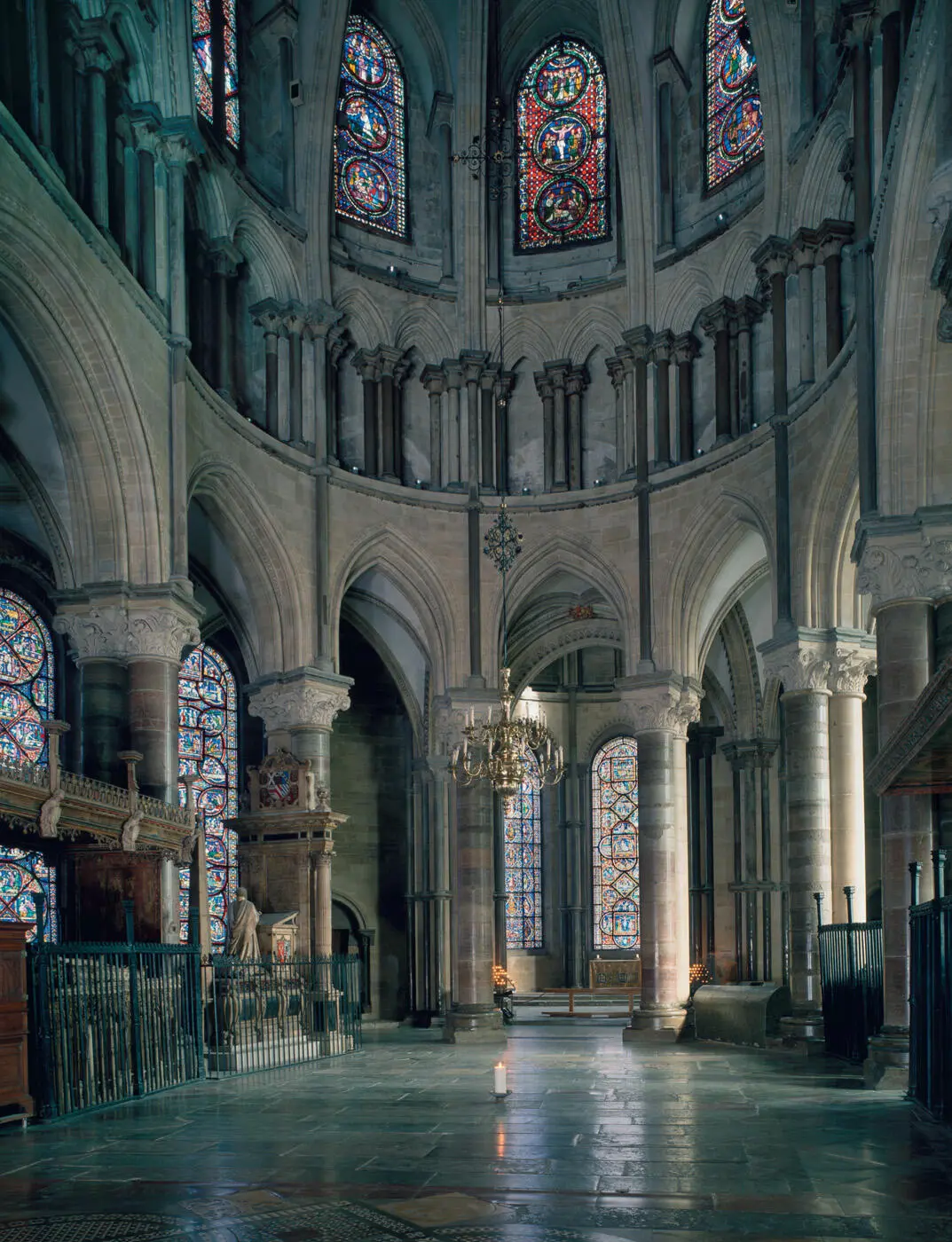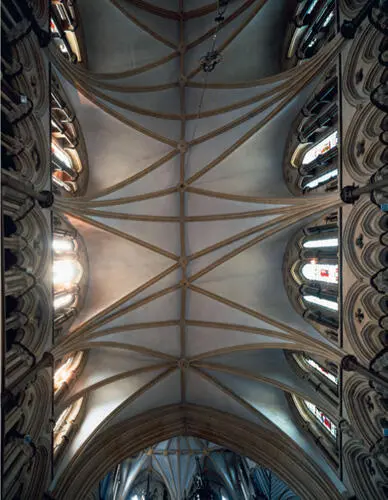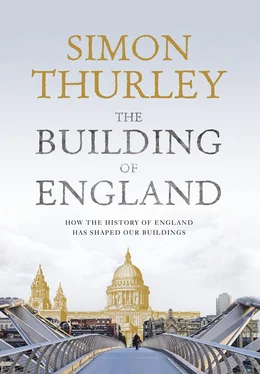
Fig. 59 Canterbury Cathedral, Kent, looking east; the choir of 1175–84. Its principal architectural characteristic is the height of the main arcade, more than half the height of the whole elevation; above are clusters of polished black Purbeck marble shafts used for the first time in England. These lead the eye up to the high vaults, in six parts, with decorated ribs that complement the beautifully carved capitals of the arcade far below. Beyond is the presbytery ( fig. 60).
The adoption of Gothic detailing at Byland and then at York Minster was very influential in the north, but the repercussions of events at Canterbury between 1170 and 1175 were of much greater national impact. The most famous murder in English history took place on 29 December 1170 in Canterbury Cathedral; its victim was Archbishop Thomas Becket. Within days miracles were reported. The dead archbishop rapidly became a martyr and, within three years, a saint. This was a turning point in the history of Canterbury. Another took place eighteen months after Becket was canonised: the gutting of Archbishop Anselm’s early 12th-century choir by fire. This gave the Canterbury monks the opportunity to create a spectacular new setting for their saint and his relics. After consulting a number of architects, the monks chose a Frenchman, William, who came from the French city of Sens, the location of a new cathedral built in the Gothic style. As the monks wanted to ensure continuity with their much-loved building, he decided to retain the crypt and the lower, undamaged, parts of the choir and construct inside it a new east end.
So what was new about William of Sens’s choir ( fig. 59)? Compared with the Anglo-Norman work of the nave the arcades were much taller, with gently pointed arches squeezing those of the gallery above. The vault springs from a low point and its ribs are decorated with dog-tooth motifs. The piers themselves were more slender and furnished with carved capitals. Polished limestone was used to enliven the elevations. William of Sens fell from his own scaffolding while supervising the construction of the highest vaults over the eastern crossing. He tried to carry on the work from his sick bed but had to return to France. His replacement was another William, known as ‘the Englishman’. He not only completed the repair of the fire damage but was commissioned to build an enlarged chapel to the east of it to replace the Trinity Chapel, the crypt of which contained the relics of St Thomas. This was to have two parts: the Trinity Chapel itself and beyond that a circular shrine called the Corona, where the severed crown of the martyr’s head was housed. The Englishman continued the main features of the choir through to the new chapel, which, being raised above a higher crypt, had shorter piers and much more satisfying proportions ( fig. 60). The big windows were made possible by some of the earliest visible flying buttresses anywhere. The stained-glass scenes of the life of Christ and the miracles of St Thomas Becket are still largely intact, held in place by geometric iron frameworks (ferramenta). Their colours intensify the effect of the polished limestone columns, the use of which becomes progressively denser as the visitor moves eastwards. In the chapel the arcade piers are doubled-up and entirely made of Purbeck marble, while those nearest the shrine are of a hard pink-and-cream marble imported from abroad.

Fig. 60 Canterbury Cathedral, Kent. The presbytery was the culmination of the cathedral and the location of St Thomas’s shrine from 1220 until its destruction in 1538. The use of polished limestone made a huge impact on both pilgrims and masons from elsewhere. The survival of the original glass is nothing short of miraculous.

Fig. 61 Wells Cathedral, Somerset; the nave is now dominated by the scissor braces at the crossing added in the 14th century. Here the arcade and the clerestory are practically the same height and the triforium becomes a decorative band containing a denser rhythm of arches between the two. The effect of this was to abolish the rhythm of the bay structure and emphasise the great length of the cathedral, now, of course, interrupted by the scissor brace.
The experience of moving eastwards through Canterbury Cathedral towards the Corona is breathtaking. It is necessary to ascend steps over both Lanfranc’s and William the Englishman’s crypts to enter the extraordinary world of polished stone designed to evoke the heavenly Jerusalem in the Book of Revelation. A pilgrim would have felt as if he had been shrunk and placed inside an enamelled reliquary like the Becket casket in the Victoria and Albert Museum. Canterbury was to be influential, not so much through the details of its style or construction (although these were important), but for its lavishness. It was the mother church of England and set the standard for all that came after, particularly in its extravagant use of polished stones. Although Canterbury has more directly French features than any other English building of its age, its successors created a very different look, much more English and, in a sense, much more original. The rebuilding of Wells Cathedral was started soon after 1175 as a deliberate bid to replace Bath as the centre of the diocese of Somerset. It was sufficiently complete to be dedicated in 1239. Over a 60-year period it had at least three architects, all of whose genius must be recognised; for the building that they created was of huge originality and skill. It was the first building in England, if not in the whole of Europe, to be built with pointed arches throughout. But more important was the way the arches were handled. The overwhelming sensation gained by a visit to Wells is the horizontal effect of the nave created by three self-contained strata of arches ( fig. 61). The lowest, the nave arcade, is supported by massive cross-shaped piers faced with 24 shafts bunched in groups of three. In Anglo-Norman cathedrals there was a substantial gallery above the nave arcades but at Wells there is the semblance of a triforium, which in French buildings is a much narrower passage in the thickness of the wall, fronted by an arcade. This arcade runs the entire length of the nave as a consistent band of decoration without vertical interruptions. Above is the clerestory, with the ribs of the vault supported on stubby shafts. 8

Fig. 62 Lincoln Cathedral; the vault of St Hugh’s Choir of about 1200, the first instance anywhere of a rib that ran along the ridge of the vault. To this rib join ribs that have little structural necessity and do not define the bay structure – in other words, they are pure decoration.
Ideas from Canterbury and Wells fed into the greatest of early English Gothic churches: the cathedral at Lincoln. In 1185 a vault in the east end of the cathedral collapsed and the following year Henry II appointed Hugh of Avalon as the new bishop. These two events led to a rebuilding of the eastern parts, largely completed by the time of Hugh’s death in 1200. This probably finished the original plan; but work continued and by about 1250 the whole cathedral, save the Norman west front, had been rebuilt. Lincoln was rebuilt in its own image. This was a cathedral that proclaimed its place at the top of the hierarchy, together with Canterbury and York. As a result nobody stinted on money, scale or decorative effect. Lincoln set out to dazzle – and dazzle it does.
Читать дальше
















